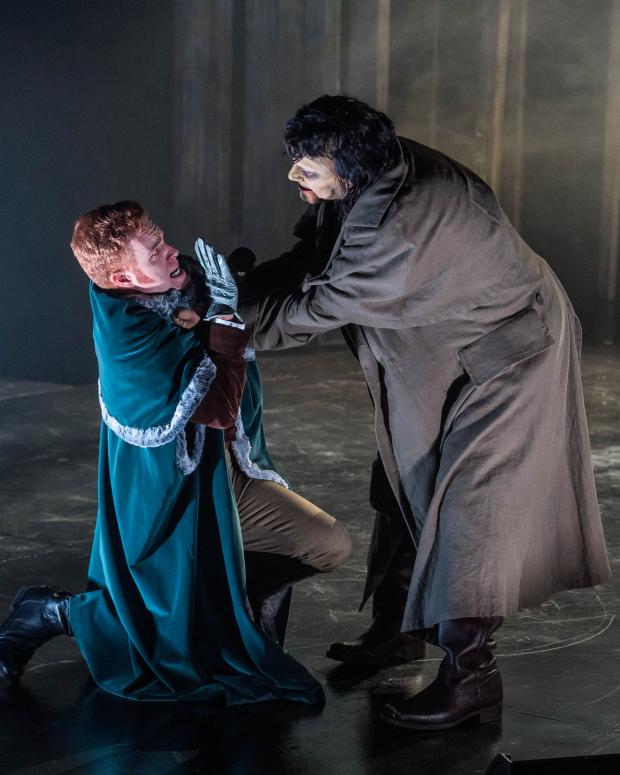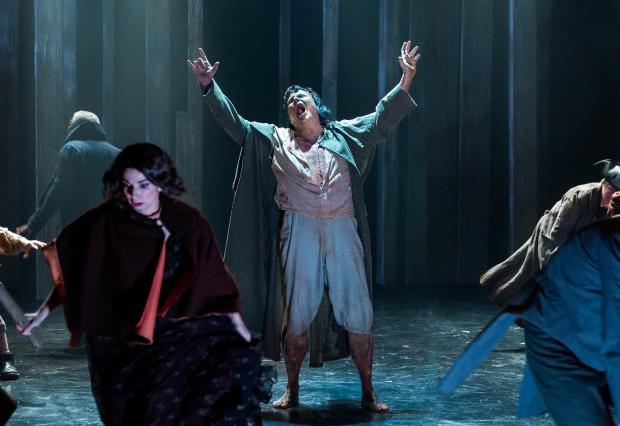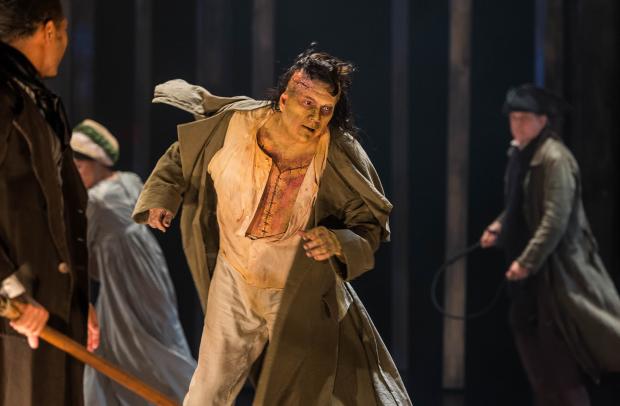A Noise Within’s Frankenstein is one of the most unique plays I’ve ever seen. Using British playwright Nick Dear’s adaptation, the drama opens with one of the best “jump cuts” I’ve seen since that ape-like being in 2001: A Space Odyssey tossed his bony weapon into the air, which transitions to a spacecraft in the heavens. Dispensing with lots of exposition this stage production cuts right to the chase, presumably because most theatergoers are already familiar with the world famous story, as related in Mary Wollstonecraft Shelley’s immortal (no pun intended) 1816 Gothic novel, and in countless retellings, most notably in the still unsurpassed 1931 James Whale movie of the same name starring Boris Karloff.
While this approximately two hour show without intermission has its fair share of action it stresses the psychological aspects inherent in the plot of Shelley’s horror story. In the early 19th century Dr. Victor Frankenstein (Kasey Mahaffy) cobbles together a Creature (Michael Manuel) from corpses and body parts, which he animates via electric shocks (about 150 years before they were key elements in Ken Kesey’s One Flew Over the Cuckoo’s Nest). The “monster’s” hideousness causes the scientist to flee and the play explores the Creature’s abandonment issues and a troubled father-son relationship more complex than anything Russian novelist Ivan Turgenev ever wrote.
Shortly after her birth in 1797 Mary Shelley’s mother died and two of poor Mary’s own babies died shortly after being born, including one when she was about 17, not long before writing her monstrous masterpiece. Mary’s son William, named after her father the philosopher William Godwin, succumbed to malaria when he was only about three years old. One can imagine how these heartbreaking losses impacted Mary and she sublimated them into her saga.
Although her Creature has the body of a man, mentally he is only a child and must learn the ways of the world, as a baby does: How to talk, walk, etc. In this Freudian Frankenstein Victor’s creation yearns for a female companion (in a sly bit of double casting Erika Soto plays both the Female Creature and Victor’s fiancée, Elizabeth). However, this is a bit like a child pursuing sex, which remains an extremely taboo subject, although Sigmund Freud theorized that children could have a type of psychosexuality. And while 21st century men and women grapple with the issue of same sex relationships, Frankenstein ponders same species sex.
Shelley’s mother, Mary Wollstonecraft, was one of the 18th century’s great feminists. Her free thinking daughter injected her science fiction novel with lots of subtext about sexuality and gender roles, and enough sexual politics to fill a Kate Millett manifesto. Victor is arguably driven to “galvanize” his Creature into life as a form of displacement - as a male he is unable to give birth like women can, and he yearns to “misappropriate” that singularly female role by harnessing the powers of science. He sublimates the sexuality he should be expressing with Elizabeth into his monomania of creating life.
Indeed, more than anything, Frankenstein - which was also titled The Modern Prometheus - is a reaction against the forces of science being unleashed by the industrial revolution. It is an expression of the ethos of Romanticism, the early to mid-19th century movement which celebrated nature, passion, the individual and rejected the rational. Above all else Mary is warning Man not to tamper with the natural world, for by doing so he throws things out of kilter. Given the growing threat of climate change Shelley’s cautionary tale remains all too relevant. And with the development of automation, androids and genetics, the notion of man playing god is very apropos. It’s still not nice to fool Mother Nature!!! (All this fits neatly with the theme of ANW’s new season: “They Played With Fire.”)
Michael Michetti - who previously helmed another adaptation for ANW of a horror story by an author from the British Isles, Oscar Wilde’s The Picture of Dorian Gray - creatively, imaginatively directs Frankenstein, with minimal sets (unlike the lavish Broadway adaptation of Mel Brooks’ Young Frankenstein). Nevertheless, scenic designer Francois-Pierre Couture’s sets are very expressive - and his evocation of the Arctic is simply, yet very cleverly wrought.
The director elicits finely honed performances from his thesps. When Victor defends his sanity I heard echoes of the buffoonish Trump’s absurd claims that he’s “a very stable genius.” (Apparently we’ve “evolved” from mad scientists to science deniers.)
Michetti pointed out to me that unlike Shelley’s novel the play is told mainly from the Creature’s point of view. Movement director Rhonda Kohl (who also assistant directed) and makeup and prosthetics designers Shannon Hutchins and Angela Santori helped transform Michael Manuel into the monster you love to hate. Of course, Manuel’s talent is ultimately what delivers his moving performance. Possibly the highest compliment one could make to Manuel’s ability as an actor is that off the boards and out of costume, cosmetics and wig, this “monster” is actually a good looking guy. He explained to me at the reception that depicting the Creature requires synthesizing the outer with the inner, combining stage technique, plus reacting to the other actors.
Among them is Tania Verafield, who is becoming an ANW fixture and here plays a supporting role as Agatha, the daughter-in-law of the blind man De Lacy (Harrison White). Unable to see, De Lacy befriends the Creature who is hunted and haunted by “normal” people. This may also be a sly bit of casting since White is Black - this could be a commentary on prejudice based on physical appearances. (The 1965 Civil Rights era movie A Patch of Blue, starring Sidney Poitier befriending a sightless white woman, likewise cleverly used this conceit.) In any case, like the talented Tania, De Lacey also has other small roles as part of the ensemble that at times includes enraged mobs of villagers (although I didn’t see any of them wielding pitchforks).
How did the 18-year-old Mary Wollstonecraft Shelley conjure up her Gothic classic? In the summer of 1816 Mary “chateau-ed up” with poets Percy Bysshe Shelley (her lover and future husband) and Lord Byron in Villa Diodati, located in the scenic village of Cologny. The mansion is perched above the Swiss city of Geneva and the right bank of Lake Geneva (aka Lac Leman). The greatest horror story ever told was spawned near picturesque wineries, surrounded by sublimely breathtaking beauty.
However, when Mary and Percy visited Lord Byron it was hard to see the surrounding splendor. In 1816 Indonesia’s Mount Tambora’s volcanic eruption caused Europe to experience a gloomy summer. Immersed in darkness the writers passed their time creating supernatural sagas, teenaged Mary wrote that little book called Frankenstein - and the rest is history. Villa Diodati is now privately owned but visible from the narrow, twisting roadside, along with its commanding view of beautiful Lac Leman.
ANW is opening its 2019-2020 repertory season with a, uh, monster hit. Its stage version of Mary’s Frankenstein does justice to her romantic vision. One could sum up the quality and power of this rendition by quoting those unforgettable words shrieked by Colin Clive as Victor in 1931’s Frankenstein: “IT’S ALIVE!!!” (See: https://www.youtube.com/watch?v=1qNeGSJaQ9Q.)
Frankenstein plays through Sept. 8 at A Noise Within, 3352 East Foothill Blvd., Pasadena, CA 91107. Free parking is in an adjacent garage. For exact times, dates and more info: (636)356-3121; www.anoisewithin.org.
L.A.-based film historian/critic Ed Rampell is co-author/author of “The Hawaii Movie and Television Book” (see: https://mutualpublishing.com/product/the-hawaii-movie-and-television-book/ ). Rampell is co-presenting the 400TH Anniversary Anti-Slavery Cinema Commemoration 12:00 - 10:00 p.m., August 25 at the L.A. Workers Center.



